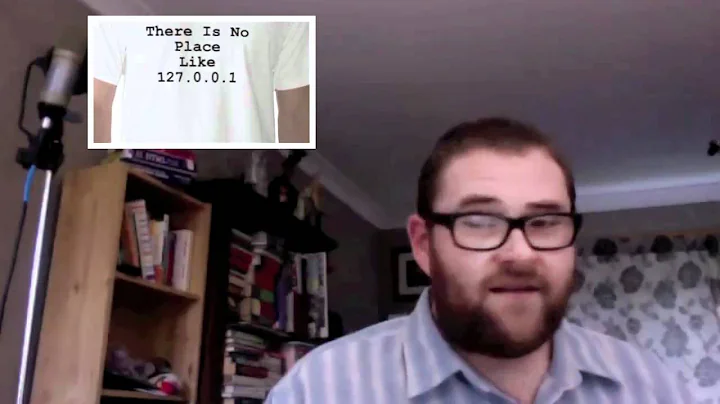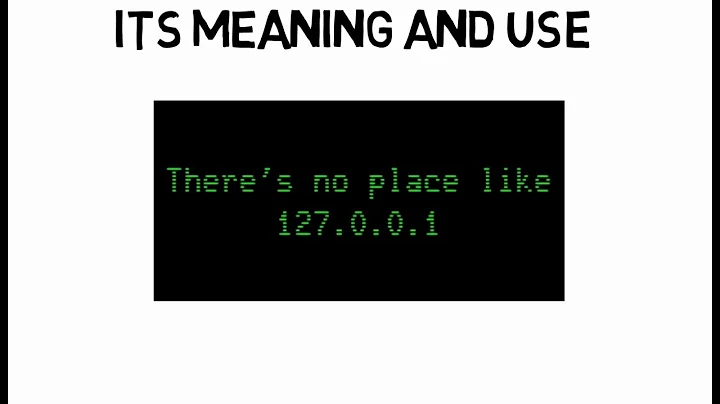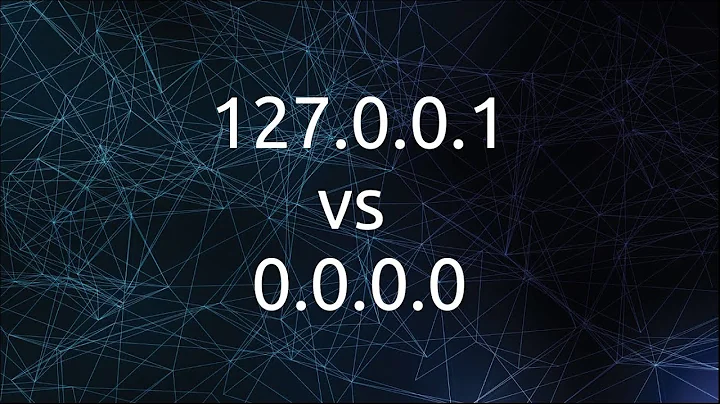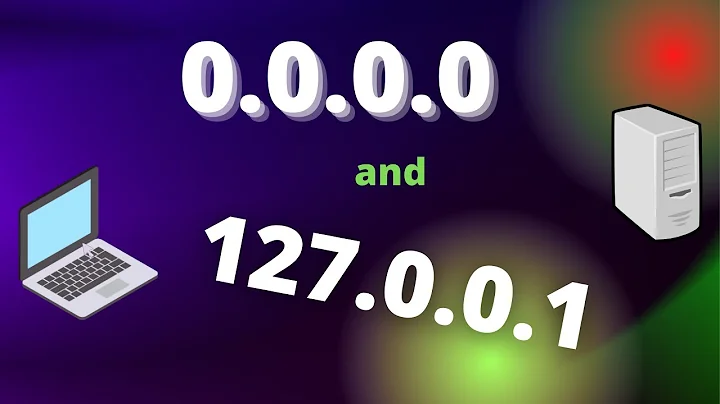Why is localhost IP 127.0.0.1?
Solution 1
127 is the last network number in a class A network with a subnet mask of 255.0.0.0. 127.0.0.1 is the first assignable address in the subnet. 127.0.0.0 cannot be used because that would be the wire number. But using any other numbers for the host portion should work fine and revert to using 127.0.0.1. You can try it yourself by pinging 127.1.1.1 if you'd like. Why they waited until the last network number to implement this? I don't think it's documented.
Solution 2
Earliest mention I can find regarding 127's assignment as loopback is November 1986 RFC 990 authored by Reynolds and Postel:
The address zero is to be interpreted as meaning "this", as in "this network".
For example, the address 0.0.0.37 could be interpreted as meaning host 37 on this network.
...
The class A network number 127 is assigned the "loopback" function, that is, a datagram sent by a higher level protocol to a network 127 address should loop back inside the host. No datagram "sent" to a network 127 address should ever appear on any network anywhere.
Even as early as September 1981 RFC 790, 0 and 127 were already reserved:
000.rrr.rrr.rrr Reserved [JBP] ... 127.rrr.rrr.rrr Reserved [JBP]
0 and 127 were the only reserved Class A networks by 1981. 0 was used for pointing to a specific host, so that left 127 for loopback.
I know this doesn't answer the question, but this is as far back as I could dig. It might have made more sense to choose 1.0.0.0 for loopback but that was already given to BBN Packet Radio Network.
Solution 3
The designers of the Internet really knew how the hardware worked, and they designed with low level implementation in mind.
The values 0, 127 and 255 are special in 8 bit assembly and machine language programming because there are "tricks" you can use to test for these values and branch to different code using smaller instructions that execute faster than for other integers. 127 is the highest signed 8 bit integer, so incrementing it by 1 will cause a signed overflow. Similarly, incrementing 255 will cause unsigned overflow. Merely loading the value 0 into a register will usually set a zero flag on the chip. Imagine the networking program looks like this in pseudocode:
if (value == 0) doLocal();
if (value == 127) doLoopback();
if (value == 255) doNetwork();
Although it depends on the chip, in those days most chips could encode these tests with 2 words, 3 words and 3 words respectively (total 8 words) and further those particular tests were all likely to execute in 1 clock cycle each. Using any other value would probably require 4 words each (total 12 words), a 50% increase in code size and likely a 50% increase in execution time as well.
Solution 4
Because when those standards were created, computers were slow and usually limited to 8 bit registers. Comparing numbers to numbers was very slow, expecially if those numbers had to be fetched from the back then REALLY slow memory. Registers, that is "CPU on board" storage were much faster.
Moreover those old computers had special, faster instructions to detect "equal to zero", "different than zero", "negative / positive integer" (where the sign was... guess what, the leftmost bit, now see a connection with 127, that is the number with all binary "1" except the leftmost = sign?).
Therefore those were special numbers, because they allowed programming trickery to save a lot of CPU cycles on frequently done operations.
You'd never see a "IF CallerIP = "0" but a "IF NotZero(CallerIP)" instruction.
You could go check ancient assembly instructions like "BEQ, BNE" (6502 CPUs) for longer explanations. Also check this page out.
In the end:
0, 255 and 127 could all be checked for with an one, fastest, instruction. Even more high level languages like C have "shortuct" comparison functions that the compiler may internally optimize into a one instruction.
Years 70 and 80 programmers really produced magnificent architectures with super-scarce resources, behind standards like IP numbering there's a lot of thought and genius.
Solution 5
If you think about what a localhost or loopback IP address means, you realize that you never want to see that address, or the network that that address belongs to, outside of a host. (Inside of a host, it's too dark to see it. Apologies to Mark Twain.)
So, someone had to pick an IP network to represent this localhost address. I don't recall who first chose it, but it's specified in the IETF Request for Comments that is periodically issued as "Host Requirements".
It was done so long ago, that the idea of "wasting" an entire class A address didn't enter anyone's mind at the time.
The utility of localhost is that you can talk to yourself using a hard-coded IP address. It was used long before there was the Domain Name System. You could actually use any of the 127.x.x.x valid addresses, but no one ever does. You can't sneak and use 127 as a real network because the "Router Requirements" RFC disallows ever routing that network on any internet.
Related videos on Youtube
Roee Adler
Lover of technology and science and Battlestar Galactica.
Updated on September 17, 2022Comments
-
 Roee Adler over 1 year
Roee Adler over 1 yearI wondered what is the origin of the decision to make
localhost's IP address127.0.0.1. What is the "meaning" of127? what is the "meaning" of0.0.1?-
hyperslug over 14 yearsI'm curious about this too. The IPv6 loopback is 0:0:0:0:0:0:0:1, which makes sense to me.
-
 Roee Adler over 14 yearsYes, IPv6's localhost does not raise too many questions :)
Roee Adler over 14 yearsYes, IPv6's localhost does not raise too many questions :) -
new123456 about 13 years@Wil Compress it to "there's no place like ::1" and you'll get a bit more business.
-
Nick T about 11 years@WilliamHilsum expand it to "There's no place like 0000:0000:0000:0000:0000:0000:0000:0001" and charge more.
-
 Criggie over 6 yearsFor interest, in the early 2000 I tried redefining localhost on a virtual network. Linux was quite happy to have 127.0.0.1/24 assigned to lo, as was BSD. But try the same on a windows box and it sulked as soon as I typed in "127" into the network config box. Was either win98 or winXP.
Criggie over 6 yearsFor interest, in the early 2000 I tried redefining localhost on a virtual network. Linux was quite happy to have 127.0.0.1/24 assigned to lo, as was BSD. But try the same on a windows box and it sulked as soon as I typed in "127" into the network config box. Was either win98 or winXP.
-
-
RoyalKnight over 14 yearsThe only reasons I would see them arbitrarily choosing 127 is that it's an easy number to remember (01111111), and perhaps they were allowing 16 million host addresses for being able to communicate with itself and itself only (like how some programs and Windows components use ports nowadays). The RFCs only really mentioned that it's standard practice for 127.0.0.1/32 to be used for loopback. It's quite nebulous as to what they intended for the rest of the block aside from it looping back to the host and never hitting the network, hence my above speculation.
-
 Roee Adler over 14 yearsHow come it's obvious again?
Roee Adler over 14 yearsHow come it's obvious again? -
Mushex Antaranian over 14 yearsso why not 10111111 ? :) or 11011111 or 11101111 or 11110111 or 11111011 or 11111101 or something like it ?
-
 jlliagre over 13 yearsHaving all the block addresses reverting to 127.0.0.1 is implementation dependent and might perhaps just be a Linux stack peculiarity. Solaris at least requires an interface to be bound to the destination address for your ping test to succeed.
jlliagre over 13 yearsHaving all the block addresses reverting to 127.0.0.1 is implementation dependent and might perhaps just be a Linux stack peculiarity. Solaris at least requires an interface to be bound to the destination address for your ping test to succeed. -
Joseph Bui about 13 yearsNote that I used "words" because old machines back then had unusual word sizes, but they often still used 8 bit arithmetic. For an 8088, I would have said "bytes."
-
Ardee Aram almost 11 yearsNope. Try again.
-
not2qubit over 6 yearsGreat answer. This is really the clearest and most sensible explanation.
-
 user over 6 yearsActually, back when IP was designed and some of the early groundwork for it was laid down, working with data in integer multiples of 8 bits wasn't a given. Many architectures at that time had registers and word sizes in multiples of 12 or 18 bits, for example. This is one reason why octal was so popular at the time; 18 bits can be represented as exactly 6 octal digits with no loss and no waste; 12 bits is 4 octal digits. Microcomputers typically worked in 8-bit quantities, but it was only much later that microcomputers started being regularly connected (especially directly) to the Internet.
user over 6 yearsActually, back when IP was designed and some of the early groundwork for it was laid down, working with data in integer multiples of 8 bits wasn't a given. Many architectures at that time had registers and word sizes in multiples of 12 or 18 bits, for example. This is one reason why octal was so popular at the time; 18 bits can be represented as exactly 6 octal digits with no loss and no waste; 12 bits is 4 octal digits. Microcomputers typically worked in 8-bit quantities, but it was only much later that microcomputers started being regularly connected (especially directly) to the Internet. -
Ellie Kesselman over 2 yearsVery nice answer, @Dario Fumagalli. I also like your comments on SE Politics!




